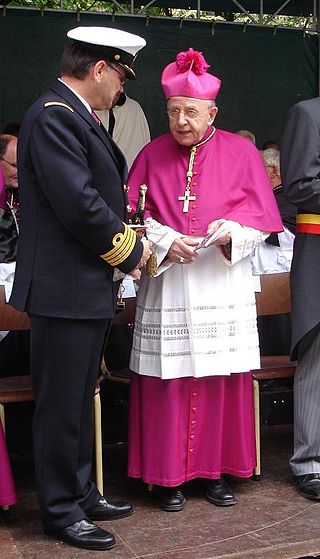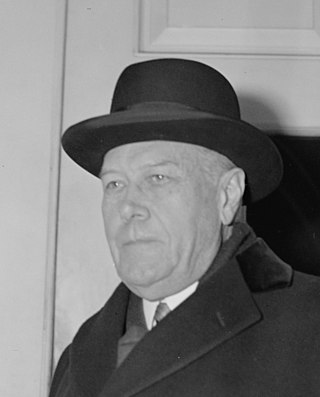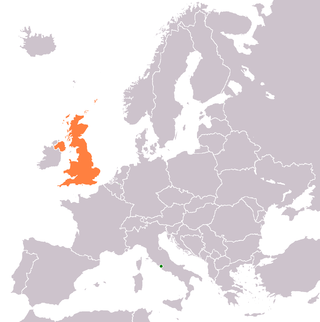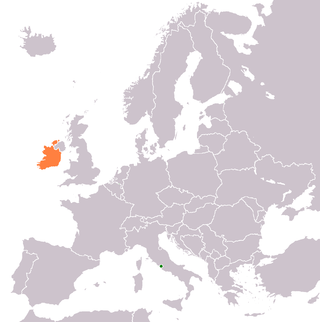
An apostolic nuncio is an ecclesiastical diplomat, serving as an envoy or a permanent diplomatic representative of the Holy See to a state or to an international organization. A nuncio is appointed by and represents the Holy See, and is the head of the diplomatic mission, called an apostolic nunciature, which is the equivalent of an embassy. The Holy See is legally distinct from the Vatican City or the Catholic Church. In modern times, a nuncio is usually an archbishop.

Myron Charles Taylor was an American industrialist, and later a diplomat involved in many of the most important geopolitical events during and after World War II.

The Apostolic Nunciature to the United States, sometimes referred to as the Vatican Embassy, is the diplomatic mission of the Holy See to the United States. It is located at 3339 Massachusetts Avenue, Northwest, Washington, D.C., in the Embassy Row neighborhood. Since 2016, the papal nuncio has been Cardinal Christophe Pierre.

The current United States Ambassador to the Holy See is Joe Donnelly, who replaced the ad interim Chargé d'Affaires, Patrick Connell, on April 11, 2021. The Holy See is represented by its apostolic nuncio, Cardinal Christophe Pierre, who assumed office on April 12, 2016. The U.S. Embassy to the Holy See is located in Rome, in the Villa Domiziana. The Nunciature to the United States is located in Washington, D.C., at 3339 Massachusetts Avenue, N.W.

Relations between the Holy See and the Republic of China were established on a non-diplomatic level in 1922 and at a diplomatic level in 1942. The Holy See, under the One-China policy, recognizes the Republic of China as the representative of China.

Holy See–United Kingdom relations are foreign relations between the Holy See and the United Kingdom.
The Holy See has long been recognised as a subject of international law and as an active participant in international relations. One observer has stated that its interaction with the world has, in the period since World War II, been at its highest level ever. It is distinct from the city-state of the Vatican City, over which the Holy See has "full ownership, exclusive dominion, and sovereign authority and jurisdiction".

Holy See–Ireland relations are foreign relations between the Holy See and Ireland. The majority of Irish people identify as Roman Catholic, according to census data. However, views on actual church dogma both on social and spiritual matters varies significantly, and weekly mass attendance is below 40%. The Holy See has an Apostolic Nunciature in Dublin.

Holy See – Mexico relations are foreign relations between the Holy See and Mexico. Catholicism was introduced in Mexico in 1519 by the Spanish Empire. The majority of Mexicans practice the Catholic faith, however, since the adoption of the current Constitution in 1917, Mexico is a secular nation.

Holy See–Vietnam relations are foreign relations between the Holy See and Vietnam.
The Embassy of the United States of America to the Holy See is the diplomatic mission of United States of America to the Holy See, a term referring to the central government and universal reach of the Roman Catholic Church.

Foreign relations of Pope Pius XII extended to most of Europe and a few states outside Europe. Pius XII was pope from 1939 to 1958, during World War II and the beginning of the Cold War.

Eugenio Cardinal Pacelli visited the United States for two weeks in October–November 1936 as Cardinal Secretary of State and Camerlengo of the Holy Roman Church. At the time, Pacelli was the highest-ranking Catholic official ever to visit the US. Although he did not visit the US as Pope, he was the first Pope who visited the US at any time in his life.

Kenneth Francis Hackett served as the United States Ambassador to the Holy See from August 2013 until January 2017. He was previously president of Catholic Relief Services (CRS).

Holy See–Philippines relations refers to the relations between the Holy See and the Philippines. As one of two Catholic-majority countries in Asia, the Philippines enjoys significant relations with the Holy See. The Holy See has a nunciature in Manila, and the Philippines has an embassy to the Holy See based in Rome.

Larry Wang or Wang Yu-yuan is a senior diplomat of the Republic of China (Taiwan). He is a native of Wujin County, Jiangsu Province. He is proficient in English and Spanish.

The Embassy of the Philippines to the Holy See is the diplomatic mission of the Republic of the Philippines to the Holy See, the central government of Vatican City and the Roman Catholic Church. Opened in 1957, it is located along Via Paolo VI in the rione of Borgo, part of Municipio I in central Rome along the border between Italy and Vatican City, and across from St. Peter's Square.


































